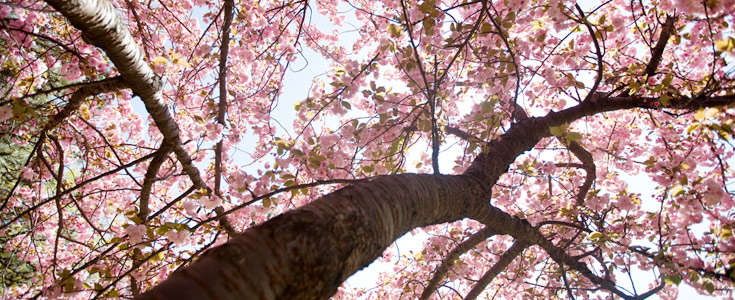

Photograph © Yong Hee Kim
Conceived by Frederick Law Olmsted, Sr. and Calvert Vaux in 1867, the 370-acre park was later designed by John Charles Olmsted and Olmsted Brothers between 1898 and 1937. Today, listed on both the New Jersey and National Register of Historic Places, Essex County Branch Brook Park is the premier park of the Essex County Park System, America’s first County park system. The Fuld Collection of Japanese Flowering Cherry Trees, established in 1928, is located in the northernmost extension of the park. The sheer number of varieties, and the complexity of its setting and scenery, rivals the more famous collection in Washington, D.C. Poor maintenance now threatens the tree collection.
History


(top) Branch Brook Drive circa 1957; (bottom) Cherry trees along
the Second River circa 1950. Courtesy Rhodeside & Harwell
Conceived by Frederick Law Olmsted, Sr. and Calvert Vaux in 1867, John Charles Olmsted and the Olmsted Brothers firm designed the 370-acre Branch Brook Park starting in 1898. With construction of the initial phases of Branch Brook Park almost complete in 1913, the Essex County Park Commission suggested adding flowering cherry trees to the design. Inspired by the spring-time show of cherry blossoms around the Potomac Basin in Washington, D.C., Caroline Bamberger Fuld, sister of the president of Bamberger’s Department Store, became intent on creating a display of specimens in Essex County that would rival the collection in the nation’s capital. Mrs. Fuld looked to the Olmsted firm to undertake a design for the collection and Percival Gallagher was assigned the task.
The firm designed the plan for the collection in 1928. Approximately 2200 flowering cherry trees of more than 20 varieties were selected at various nurseries (primarily in Pennsylvania) along with a diverse group of evergreens and shrubs, designed to contrast with the pale flowered trees in spring, and to create a lush and diverse shrub backdrop through the changing seasons. The installation was completed in 1932.
The collection included significant quantities of Yoshino cherry trees (Prunus x yedoensis), interspersed with other varieties to produce a varied effect along the length of the park drive. Gallagher’s design provided a collection mostly of single-flowered forms, chosen for their long lasting flowers and their mass effect, especially in vistas, contrasting these with groupings of the double-flowered variety, to provide interest not only in the long distance view, but also at more intimate scale.
In 1999, local residents formed the Branch Brook Park Alliance (BBPA) to restore and revitalize the park. BBPA and Essex County began rehabilitating the park in 2004 and started restoring the cherry tree collection in 2006. In addition, they created a maintenance plan for Essex County Branch Brook Park in 2009 with the goal of continuing to restore the park and manage its famed collection of cherry trees.
Today, the cherry tree collection in Branch Brook Park outshines that in Washington, D.C.’s Potomac Basin in both number and varieties and, with the expansion of the collection to over 4300 trees, is the largest collection on a single site along the East Coast. The existing collection is made up of more than 20 cherry tree varieties, including selections of Prunus serrulata, subhirtella, and yedoensis. Evergreen trees and a diverse range of native and easily naturalizing shrubs have been planted to provide contrast and texture in accordance with the Olmsted plant lists and themes. More flowering cherries have been planted in selected areas of the park to reflect and preserve the spatial characteristics of the Olmsted firm’s design.
The flowering cherry trees continue to be the focus of celebration including an annual weeklong celebration, Japanese cultural festival events, and many other activities throughout the year. Listed on both the New Jersey, and the National Register of Historic Places, Essex County Branch Brook Park is the premier park of the Essex County Park System, America’s first County park system.
Threat

Courtesy Rhodeside & Harwell
The relatively short lifespan of ornamental flowering cherry trees, the recovery of the collection from historically poor maintenance, and lack of appropriate nursery stock are all concerns for the collection at Branch Brook Park. Most of the original trees began to decline or die between 1950 and the late 1970s. By 2005, a park-wide vegetation survey revealed that only 987 cherry trees remained from the historic collection that had become crowded out by shade trees, overgrown by invasive species and not replanted as trees died or were removed. Finally, many of the older cherry trees in the park are unknown varieties. Cuttings of these oldest trees must be taken and propagated to prevent permanent loss of portions of the collection’s genetic legacy before they succumb to old age.


